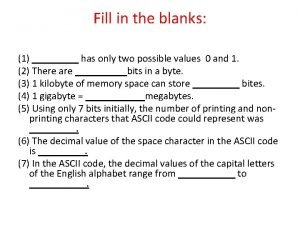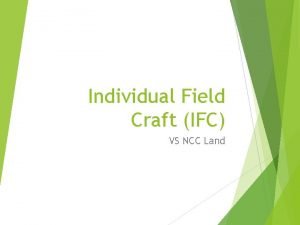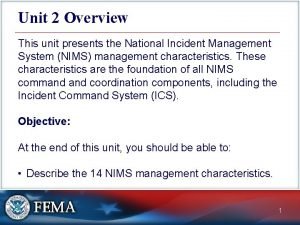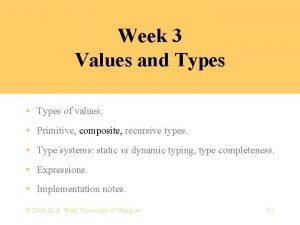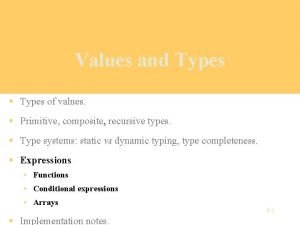Python Types Python values are of various types











- Slides: 11

Python Types Python values are of various “types” Ints, Floats, Strings, Characters, and more Two representations of numbers 1 vs 1. 0

Numeric Data Types Inside the computer, whole numbers and decimal fractions are represented (encoded) quite differently! We say that decimal fractions and whole numbers are two different data types. The data type of an object determines what values it can have and what operations can be performed on it.

Numeric Data Types Whole numbers are represented using the integer (int for short) data type. These values can be positive or negative whole numbers. Encoded in binary (last week lecture slides)

Numeric Data Types Numbers that can have fractional parts are represented as floating point (or float) values. How might we encode these? What about two numbers? How can we tell which is which? A numeric literal without a decimal point produces an int value A literal that has a decimal point is represented by a float (even if the fractional part is 0)

Numeric Data Types Python has a special function to tell us the data type of any value. >>> type(3) <class 'int'> >>> type(3. 1) <class 'float'> >>> type(3. 0) <class 'float'> >>> my. Int = 32 >>> type(my. Int) <class 'int'> >>>

Numeric Data Types Why do we need two number types? • Values that represent counts can’t be fractional (you can’t have 3 ½ i. Pods) • Most mathematical algorithms are very efficient with integers • The float type stores only an approximation to the real number being represented! • Since floats aren’t exact, use an int whenever possible!

Numeric Data Types Operations on ints produce ints, operations on floats produce floats (except for /). >>> 10. 0/3. 0 3. 333333335 >>> 10/3 3. 333333335 >>> 10 // 3 3 >>> 10. 0 // 3. 0 >>> 3. 0+4. 0 7. 0 >>> 3+4 7 >>> 3. 0*4. 0 12. 0 >>> 3*4 12

Numeric Data Types Integer division produces a whole number. That’s why 10//3 = 3! 10//3 = 3 since 3 goes into 10 3 times (with a remainder of 1) 10%3 = 1 is the remainder of the integer division of 10 by 3. a = (a//b)*(b) + (a%b)

String Arithmetic? In the first week we saw print(“Hello” + “World”) The + operator “adds” two strings together print(“Hello. World”) What if we wanted a space? print(“Hello “ + ”World”) print(“Hello” + “ “ + “World”)

String Arithmetic? We have an intuition of what + does, can we reason about * (multiplication)? print(“Hello” * “World”) ? ? ? But what about? print(3 * “Hello”) We know that 3 * 5 is short hand for: 5 + 5 … Logically 3 * “Hello” would be short hand for: “Hello” + “Hello”

String Arithmetic? We know what “Hello” + “Hello” does! It gives us: “Hello”
 Antigentest åre
Antigentest åre Human values definition
Human values definition Western vs eastern values
Western vs eastern values Machavillian
Machavillian Instrumental values
Instrumental values A bit can have only two possible values one and
A bit can have only two possible values one and Handling missing values in python
Handling missing values in python State various types of track electrification system
State various types of track electrification system Definition of field craft
Definition of field craft Cutting tools and equipment
Cutting tools and equipment Various types of reports
Various types of reports To avoid overburdening the incident command
To avoid overburdening the incident command





